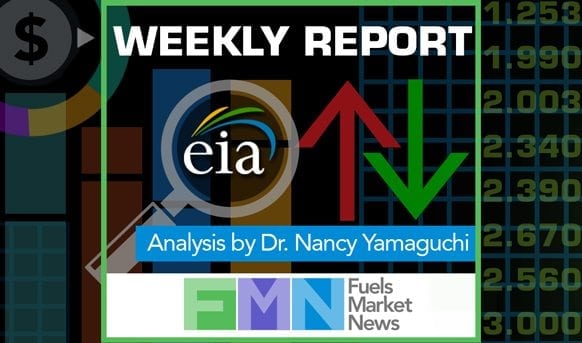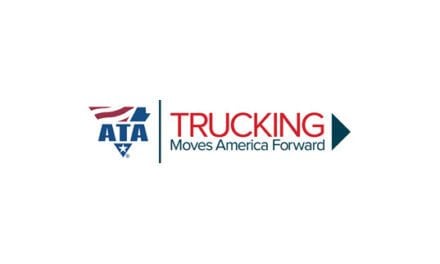Analysis by Dr. Nancy Yamaguchi
Overview and COVID-19 Apparent Demand Response
The U.S. Energy Information Administration (EIA) released its weekly data on diesel and gasoline retail prices for the week ended August 24. Retail prices for gasoline rose by 1.6 cents to average $2.182/gallon. Diesel prices, which have not yet shown a strong rebound, eased slightly by 0.1 cent per gallon. The COVID-19 pandemic caused severe demand destruction, which is reversing gradually. COVID-19 infections continue to rise, and some closures of economic activities are being reinstituted.
This week, two storm systems were tracked headed for the U.S. Gulf Coast. Storm Marco dissipated, but the other, Storm Laura, made landfall Thursday as a Category 4 Hurricane. Many US Gulf oil platforms have been evacuated, and refineries are shutting down in preparation. Localized fuels shortages could cause price hikes.
The EIA publishes weekly “product supplied” data as its proxy for demand. These data show gasoline demand crashing from 9,696 barrels per day (kbpd) during the week ended March 13 to just 5,065 kbpd during the week ended April 3, a huge hit of 4,631 kbpd in just four weeks. That was the low point. Demand thereafter trended generally up until it reached 8,608 kbpd during the week ended June 19. Since then, demand has cycled up and down. Apparent demand recovered to 8,809 kbpd during the week ended July 24, retreated to 8,617 kbpd during the week ended July 31, jumped to 8,883 kbpd during the week ended August 7, then retreated again to 8,630 kbpd during the most recent week ended August 14. The EIA points out that “product supplied” is not a precise measure of demand, but these data provide the most up-to-date numbers publicly available.
Diesel demand dropped sharply in response to COVID-19, and it is recovering in fits and starts. Diesel demand stagnated at first, recovered somewhat, then began to vacillate between approximately 3,000 kbpd and 3,800 kbpd. The EIA reported that distillate fuel oil demand plunged by 1,256 kbpd between the week ended March 13 and the week ended April 10, slumping from 4,013 kbpd to 2,757 kbpd in a four-week period. During the week ended August 7, diesel demand recovered to 3,862 kbpd. Demand fell once again, however, to 3,253 kbpd during the most recent week ended August 14.
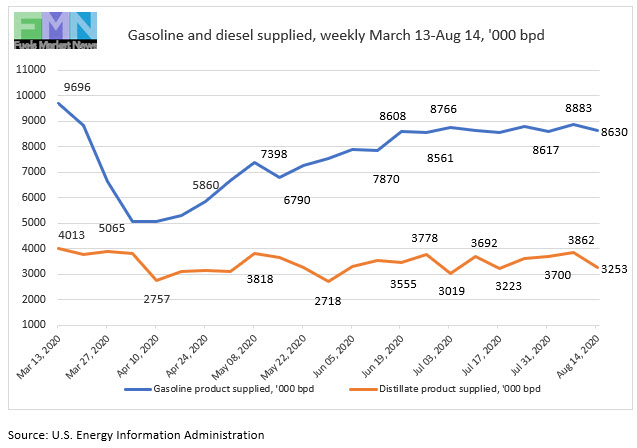
For the week ended August 24, retail prices for gasoline rose by 1.6 cents/gallon. Retail prices for diesel eased by 0.1 cent/gallon.
The national average price for gasoline was $2.182/gallon. This price was 39.2 cents/gallon below the price for the same week one year ago. In February, retail prices for gasoline were higher than they had been a year earlier. The COVID-19 pandemic caused gasoline prices to fall below $2/gallon. Now, prices in four of the five PADDs have regained the $2/gallon level. From late-November through early March, gasoline prices had been above their levels from last year. During the week ended March 2, retail gasoline prices were a mere 0.001 cent/gallon above last year’s level. The huge price declines since then have brought gasoline prices dramatically below their levels of last year.
Diesel prices also had been above last year’s level, but prices are now well below these levels. On a national basis, the retail price for diesel averaged $2.426/gallon—55.7 cents/gallon lower than the price in the same week last year. For the calendar year to date, retail prices for diesel have shed a total of 65.3 cents/gallon.
Futures Prices and Retail Price Outlook
During the week August 17 to August 21, West Texas Intermediate (WTI) crude oil futures prices rose by $0.30 per barrel (0.7%.) WTI futures prices largely had been rangebound between $39-$41 per barrel, but they broke out in August and strengthened to the $41-$42 a barrel range. This came despite a continued increase in COVID-19 infections. Global cases are approaching 23.6 million, with nearly 812,000 deaths. U.S. cases now exceed 5.7 million, with over 177,000 deaths.
During the week of August 17 to August 21, gasoline futures prices rose by 4.56 cents per gallon (3.6%.) Diesel futures prices rose by 0.24 cents per gallon (0.2%.) While the relationship between futures prices and retail prices is not immediate or one-for-one, the strength in futures prices and adverse weather suggest that gasoline and diesel retail prices should rise this week.
Retail Diesel Prices
The week ended August 24 brought a 0.1 cent/gallon decrease in the retail price for diesel. For the year to date, diesel prices have fallen by a cumulative 65.3 cents/gallon, a major downward slump that now appears to be stabilizing. In the autumn of 2019, retail diesel prices had been below the $3/gallon mark until the attacks on Saudi Arabian oil facilities in mid-September 2019. They rose at that time, and they remained above the $3/gallon mark until the week ended February 3, 2020. Prices then continued to slide. For the current week, retail diesel prices eased slightly by 0.1 cent to arrive at an average price of $2.426/gallon. Prices fell in PADDs 1 and 3, were unchanged in PADD 2, and rose in PADDs 4 and 5. The national average price for the week was 55.7 cents/gallon below where it was during the same week last year.
In the East Coast PADD 1, diesel prices eased by 0.2 cents to average $2.506/gallon. Within PADD 1, New England prices fell by 0.7 cents to average $2.620/gallon. Central Atlantic diesel prices decreased by 0.1 cent to average $2.683/gallon. Lower Atlantic prices declined by 0.2 cents to settle at an average price of $2.363/gallon. PADD 1 prices were 49.7 cents/gallon below their levels for the same week last year.
In the Midwest PADD 2 market, retail diesel prices were unchanged at an average $2.308/gallon. Prices were 58.2 cents below their level for the same week last year. PADD 2 joined PADD 3 during the week ended June 17, 2019, in having diesel prices fall below $3/gallon. Prices subsequently fell below $3/gallon in PADD 4 and PADD 1. Fourteen weeks ago, PADD 5 prices also slid below the $3/gallon mark.
In the Gulf Coast PADD 3, retail diesel prices fell by 0.3 cents to average $2.174/gallon. PADD 3 continues to have the lowest diesel prices among the PADDs, currently 25.2 cents below the U.S. average. Prices were 57.0 cents below their level for the same week in the previous year.
In the Rocky Mountains PADD 4 market, retail diesel prices rose by 0.4 cents to average $2.369/gallon. PADD 4 prices were 56.7 cents lower than for the same week in the prior year.
In the West Coast PADD 5 market, retail diesel prices rose by 0.2 cents to average $2.960/gallon. PADD 5 prices were 59.6 cents below their level from last year. Until December 2019, PADD 5 had been the only district where diesel prices were higher than they were in the same week last year. Subsequently, prices rose until this was true in all other PADDs. Prices have fallen dramatically, and the national average price is now well below its level of last year. PADD 5 prices excluding California rose by 0.4 cents to average $2.590/gallon. This price was 54.9 cents below the retail price for the same week last year. California diesel prices edged up by 0.1 cent to an average price of $3.265/gallon. Until the week ended June 24, 2019, California had been the only major market where diesel prices were above $4/gallon, where they had been for nine weeks. California prices retreated below $4/gallon from July through October, rose above $4/gallon again during the first three weeks of November, and declined since then until beginning to pick up in June and July 2020. California diesel prices were 62.2 cents lower than they were at the same week last year.
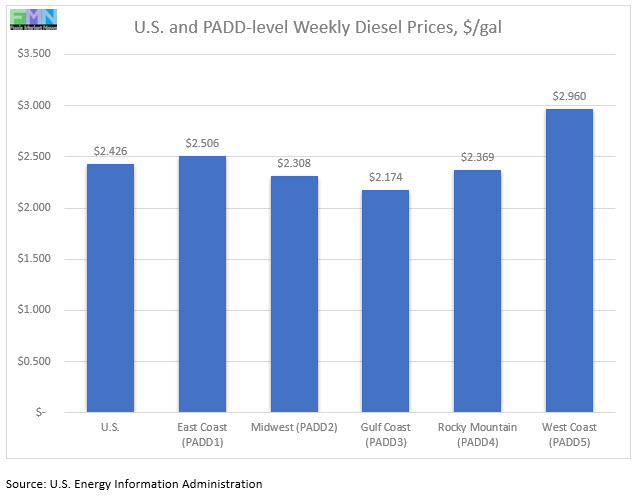

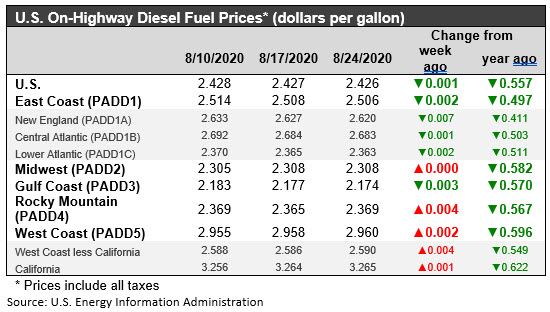
Retail Gasoline Prices
The COVID-19 pandemic is having a massive impact on the U.S. gasoline market. Retail prices for gasoline dropped below $2 a gallon in April, and they remained there throughout April, May, and into early June before finally climbing back to the $2/gallon level during the week ended June 8. Until the pandemic, it had been over four years since the average retail price for gasoline had been below the $2/gallon mark. With the phased re-opening of the economy, demand began to rise, as did prices. However, the economic reopening contributed to a resurgence in coronavirus infections, and some economic activities are being scaled back. Gasoline prices flattened over the past month.
During the current week ended August 24, average retail prices for gasoline rose by 1.6 cents to average $2.182/gallon. Prices rose in all PADDs. Retail gasoline prices for the current week were 39.2 cents per gallon lower than they were one year ago. Until November, gasoline prices had been below their levels of last year. Prices then rose to surpass last year’s levels in all PADDs. The downhill price slide changed this, making gasoline a bargain.
Looking back at historic prices, gasoline prices hit a peak of $2.903/gallon during the week ended October 8, 2018. Prices then slid downward for 14 weeks in a row, shedding a total of 66.6 cents per gallon. In the next 17 weeks, prices marched back up by 66 cents/gallon. Prices came very close to the peak they hit in early October 2018. However, the months of May and the June 2019 brought an easing of prices amounting to 23.3 cents per gallon. The week ended July 1 reversed that downward trend and sent prices up once again. The COVID-19 pandemic caused a price collapse, but prices began to climb back up in May, June, and early July. The second half of July brought a modest easing of prices, now levelling off in mid-August.
For the current week ended August 24, East Coast PADD 1 gasoline retail prices rose by 1.0 cent to average $2.096/gallon. This week’s average price was 38.7 cents/gallon below where it was during the same week last year. Within PADD 1, New England prices rose by 0.6 cents to average $2.121/gallon. Central Atlantic market prices rose by 0.2 cents to average $2.235/gallon. Prices in the Lower Atlantic market rose by 1.5 cents to average $2.003/gallon.
In the Midwest PADD 2 market, retail gasoline prices rose by 2.2 cents to average $2.073/gallon. PADD 2 prices for the week were 42.2 cents/gallon lower than they were for the same week last year.
In the Gulf Coast PADD 3 market, gasoline prices rose by 1.6 cents to average $1.866/gallon. During the week ended March 16, PADD 3 was the first region where retail prices fell below the $2/gallon level. It was joined subsequently by PADD 2, then by PADD 1, and then by PADD 4. Currently, PADD 3 remains the only PADD where prices are still below $2/gallon. PADD 3 usually has the lowest average prices among the PADDs. PADD 3 prices for the week were 39.5 cents/gallon lower than for the same week last year.
In the Rocky Mountains PADD 4 market, gasoline pump prices rose by 0.6 cents to average $2.350/gallon. This week’s PADD 4 prices were 30.0 cents/gallon lower than at the same time last year.
In the West Coast PADD 5 market, retail gasoline prices rose by 2.3 cents to average $2.855/gallon. This was the largest price hike among the PADDs. PADD 5 typically has the highest retail prices for gasoline, and until mid-March it had been the only PADD where retail gasoline prices stayed above $3/gallon. Prices this week were 37.2 cents/gallon lower than last year’s price. Prices excluding California rose by 1.8 cents to average $2.574/gallon, which was 39.6 cents/gallon below last year’s price. California prices regained the $3 per gallon level six weeks ago, and they rose by 2.5 cents during the current week to average $3.092/gallon. California had been the last state where gasoline prices had remained above the $3/gallon line, but this changed the week ended March 30. On Thursday March 19, California led the U.S. by taking the dramatic step of ordering a statewide shelter-in-place to combat the spread of COVID-19. This order affected approximately 40 million people, and it caused a dramatic contraction in fuel demand. The state began to re-open businesses and facilities in May, but COVID-19 cases are rising again, and some counties have backtracked reopening. California retail gasoline prices were 34.8 cents per gallon below their levels from the same week last year.





